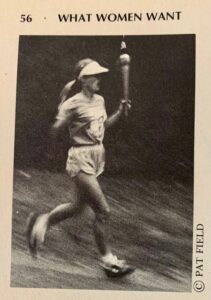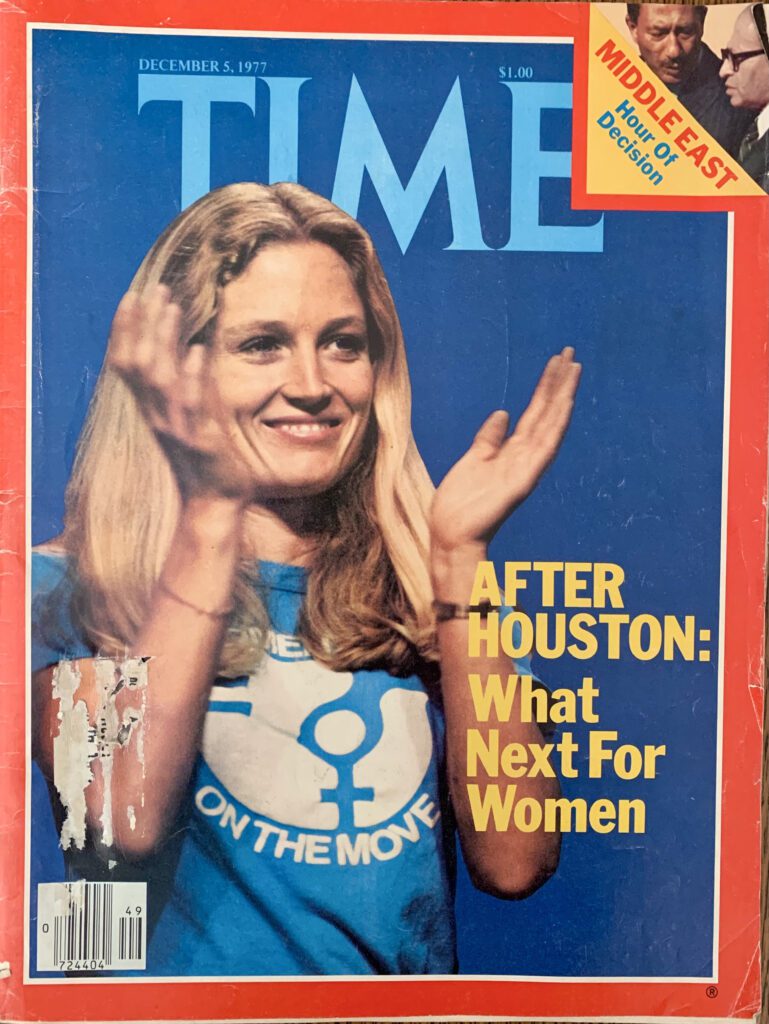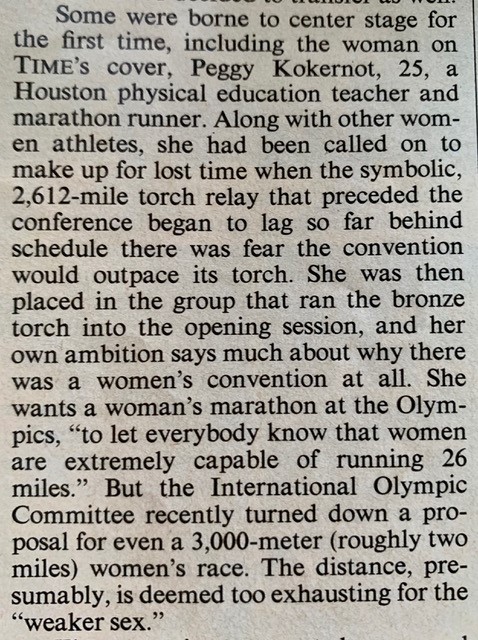Written in 2003, a reflection for the 25th anniversary of the Torch arriving in Houston to open the Women’s Conference of 1977. Submitted to Jo Freeman for National Women’s Conference website. In addition, as a veteran feminist, an interview with Edith at the 40th anniversary of the Women’s Conference can be viewed by clicking the following link:
VFA Pioneer Histories Project
Houston weather was not good that day. The crowd waited patiently at Allen Parkway in the spattering rain, but it didn’t dampen the spirit of the occasion. Hundreds of us anticipated the arrival of three torch bearers who would carry the torch the last mile to the opening ceremony of the first National Women’s Conference at the Albert Thomas Convention Center, November 18, 1977.
Thousands of volunteer women runners from fifteen states ran across America to carry the torch, relay style, a segment of the 2610 miles departing from Seneca Falls, New York on September 28th, 1977 to Houston, Texas. The torch would be lighted here in commemoration of the original site and “birthplace” of the first Women’s Rights Convention held over a hundred years ago, July 19th, 1848.
I left my office well before lunch to be there when the torch bearers arrived. We cheered as they came together for the final mile run. They were dressed in white shorts and blue t-shirts which were emblazoned with the logo of the Women’s Rights Movement: “A FLAMING TORCH SYMBOLIZING WOMEN ON THE MOVE TO LAUNCH THE WOMEN’S CONFERENCE.”

The three torch bearers with Billy Jean King
before the official march to open the Women's Conference.
These three young runners from Houston represented women of all races and ages with the common goal to celebrate women’s rights. These women were Hispanic, African American and Caucasian. I was there to see my daughter, one of the three, carry the torch. I was so proud I wanted to shout, “That’s my daughter!”
Together they raised the torch and began the last mile. Everyone in the crowd fell in behind them. I recognized Bella Abzug, IWY Commission Chair, at the head of the line in her famous oversized hat. Betty Friedan (The Feminine Mystique) and tennis star, Billie Jean King. Liz Carpenter, former Press Secretary for Lady Bird Johnson was up ahead. We followed the flame to the doors of the Coliseum. Billy Jean King waved to the thousands of women who waited at the entrance to the Convention Center. She, too, held the torch as they entered the building where thousands were waiting to greet them.
My path to that day was accidental, but not atypical. I was caught up in the Women’s Movement when I moved back to Houston in 1968. By the time of the National Women’s Conference, I had heard all the old jokes about “that shocking book” by Betty Freidan. My marriage of twenty-five years was dissolving. Our four children were having a hard time adjusting to divorcee as well as being unhappy over our move to Houston. As a divorced woman, I had no credit record, although I had paid all our household bills for years. American Express, which had been our main credit card for years, turned me down. I needed a job but hadn’t worked in over twenty years. My typing ability, not my bachelor’s degree in journalism, opened doors during my job search. Eventually, I found a job in my own field. Things began to fall into place, very slowly.
The Women’s Rights Movement impacted my life by giving me the courage to accept the challenge of change. When I overheard women and men, too, joke about ERA, how there would be no more opening of doors for women or giving up their seats, I thought, “They missed the whole point of equal rights! Had they not heard of equal pay for equal work?”
Nonetheless, I knew better than to ask to get off work to attend the three day conference. No one in my office was the least bit interested in the Women’s Conference. In fact, I sensed they disapproved. But I had to go down to the park to proudly watch my daughter and the others carry the flag the last mile.
I regretted not having been a part of the convention, but my daughter, Peggy Kokernot, gave me her firsthand account. I was grateful she had the opportunity to be part of this historic event. Little did either of us dream that this link to the convention would play an important role in her life.
Peggy had participated in college athletics during her school years. After Title IX was enacted to give women equal funding for sports, she stared the first women’s track team at Trinity University in San Antonio. She went on to win fourth place in the state for the 880-yard run. After graduation she competed in Houston races. She started with the 5K and 10K runs, and gradually worked up to the grueling 26.2 mile marathon competition.
While preparing for the January 1978 Houston Marathon she received a telephone call in mid-November from Mary Ann McBrayer, who was the Houston contact for the relay committee for the Conference. She and her husband, Tom, were runners who volunteered to work in many Houston running events which included the annual Houston Marathon.
She called to tell Peggy the relay committee faced a serious problem in Alabama, and she was asked for help to find a woman to run in Alabama. Phyllis Schlafly, the National Chairwoman of STOP ERA, a national right-wing movement had convinced the Alabama women runners not to support “this radical group of Equal Rights women under any circumstances!” and she succeeded in stopping them. There was a sixteen mile stretch in Alabama which had no available runners for the relay. The torch bearers would be stopped in their tracks with no one there to take the torch and continue the run.
Knowing Peggy was a marathon runner, Mary Ann asked her if she would agree to fly from Houston to Alabama to carry the torch through the area which had been boycotted by local joggers. Unless Peggy had taken the challenge, the torch run might have ended there. She ran the entire distance holding the torch. Shortly after here Alabama run, McBrayer invited Peggy to be one of the three women runners selected to carry the torch the last mile in Houston on November 17th.
When they entered the Coliseum the applause was deafening, Peggy had said. Over 2000 delegates rose to cheer and applause. They made their way through the crowd to the stage where the three former First Ladies (Betty Ford, Lady Bird Johnson and Pat Nixon) and First Lady, Rosalyn Carter, rose to accept the torch on behalf of the Women’s Conference.


A photograph of Peggy which was taken during the opening ceremony by a Time Magazine photographer appeared on the cover of Time, December 5, 1977. It was a complete surprise to Peggy and the “icing on the cake” for her. Time quoted Peggy as saying she wanted the Olympic Committee to offer equal status for women in sports and cited the need for a women’s marathon to be included in future Olympics. It had been deemed too difficult for women to run the 26.2 miles for the marathon course.
I went into a tiny tobacco shop outside my office and bought their entire supply of Time for Peggy. That’s when my co-workers at my office learned more about the Conference and my daughter! I am still amazed at the people, particularly women, who at that time didn’t want Equal Rights. They were polite at my office, but to them, equal rights meant never having a man let you on the elevator first, never having a man open your car door, not paying for you dinner together, not giving you a seat on a bus.
Shortly after the Women’s Convention, Peggy went on to win the 1978 Houston Marathon in January. The publicity of her victory and having her picture on the cover of Time as well, gave her confidence. Strength gathered from her ERA experience presented opportunities which otherwise might never have happened.
Seven years later, the Olympic trials for women began. Peggy qualified to enter the trials along with two hundred and fifty other women. Three American women earned the honor to run the first Olympics for the USA in 1984 when Joan Benoit of the USA won first place for women.
She was asked by the local CBS television station to do a weekly program to include tips on running. A year later her television career was launched when she became a local host of the NBC television affiliate in San Antonio for nationally syndicated P.M. Magazine.
The Conference provided Peggy’s first exposure to women who freely proclaimed their activism. After her twenty years in television, her own activism has taken her down another path. She now speaks out on issues concerning animal welfare and worked to pass legislation in Ohio for pet-friendly and horse-friendly specialty license plates. The funds go toward the improvement of their lives.
Note: Photo credit to Diana Mara Henry for the image of Billie Jean King with the three torch bearers. And, for additional information on the Houston Women's Conference of 1977 explore the following link: www.spiritofhouston.net

